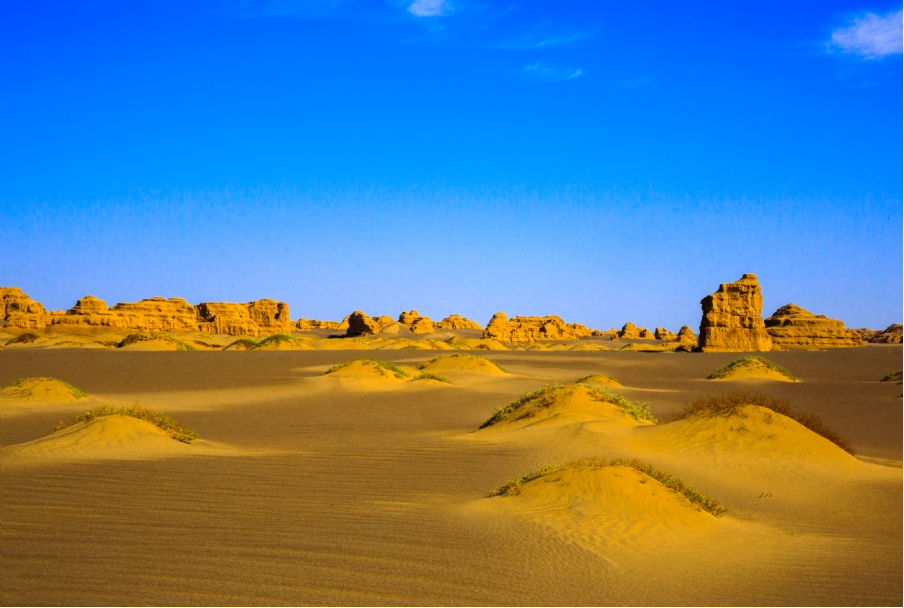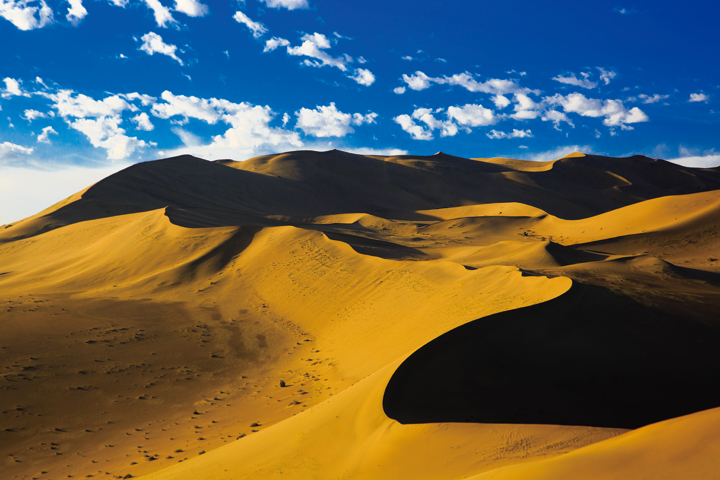The sand dunes
Dune morphology varies with wind speed, wind direction, sediment concentration and the size of obstacles. Sand dunes in the geological park can be classified according to the relationship of geomorphology formation and wind direction.
1. Sand dunes formed by single direction
The dunes are mainly formed by the wind of single direction or a few similar direction, also known as trade wind sand dunes.
(1) Fixed sand dunes
Located in the Yardang scenic area, the sand dunes can be as high as up to 1.7 meters, with white thorn on the surface as well as bulrush and cynomorium songaricum in the depression. When the sand flow meets obstacles, some sands deposit at the leeward or windward side of the obstacles, forming irregular sand bodies. As the sand deposits on both sides of the obstacle, the sand body gradually grows up (Figure. 4-9).

Figure 4-9 fixed sand dunes
(2) Crescent dune
Developed mainly in the crescent lake scenic area of the Mingsha Mountain, the plane shape of crescent dunes are like crescent, which has a slow windward slope with the slope angle 5 ° to 20 °. However, the leeward slope is deep with the angle reaching 28 ° to 34 °, closed to angle of repose of sand deposition, which is an arc toward the wind direction with the sand loose and two wing forward along the wind direction (Figure 4-10).

Figure 4-10 crescent dune
(3) Plume-shape sand dune
It is a unique kind of sand due in our country, which is mainly distributed in the Kumtag desert, southwest of the Yardang scenic area. It extends from northeast to southwest upward the slope, with lower sand ridges between the sand dunes. They are almost perpendicular, with the dunes like the axis of bird feather while the ridges like the bund on both sides of the primaries. Thus, it is known as the plume-shape sand dune. There are plume-shape dune distribution in the park, whose strike is mainly NE – SW. The NE direction corresponds to the windward slope while the SW direction corresponds to the leeward slope. The sand dunes can be 10 to15 meters high, while tongue dunes is about 0.5 to 2.3 meters high. The windward slope is slower, while the leeward slope is steeper (Jianjun Qu, et al., 2007).
The formation of the plume-shape sand dune requires flat and inclined surface as well as abundant surface sand materials. Two groups of wind with the same wind direction is the dynamic condition of its formation.

Figure 4-11 plume-shape sand dunes
2. The monsoon type sand dunes
The sand is formed by the wind with two directions, also known as the monsoon type sand dunes. The directions of wind can be skew or reverse, forming large scale sand dune chain. The sand dunes formed by two-way wind are mainly crescent dune chain (Figure 4-12).

Figure 4-12 crescent sand dune chain
It mainly develops in the Mingsha Mountain, formed under the action of winds with the direction of north by northwest and south by southwest. One of the two winds is stronger, serving as the dominant wind direction of the formation of crescent dunes. The sand dune chain is transversely connected by multiple crescent dune wing angle, which is 10 to 30 meters tall and a few hundred meters long. The dominant wind direction is vertical to the extension direction of the dunes.
3. The pyramid-shape dune
The formation of such kind of dune is relevant to the multiple direction wind caused by the interference of the moving airflow, also known as interference type sand dunes, with the pyramid-shape sand dunes the most typical ones (Figure 4-13).
It mainly develops in the Mingsha Mountain, with its shape like the cone. There are more than three triangle faces, each of which represents a wind direction. The slope angle is about 30 °, and the sand body is 50 to 100 meters high. It is formed in the condition that wind of more than three directions intersect and are of the similar power. When they are contradict to each other, the sand deposits and thus forms the pyramid-shape dune.

Figure 4-13 pyramid-shape dune
 简体中文
简体中文
